Classification of Arctic Sea Ice Type in CFOSAT Scatterometer Measurements Using a Random Forest Classifier
Abstract
1. Introduction
2. Datasets
2.1. CFOSAT Scatterometer (CSCAT)
2.2. National Snow and Ice Data Center Sea Ice Concentration and Age Product
2.3. OSI SAF Sea Ice Type and Drift Product
2.4. IUP Multiyear Ice Concentration Product
2.5. Synthetic-Aperture Radar (SAR)-Based Sea Ice Type Products
3. Methodology
- (1)
- The selection of machine-learning-aided sea ice classification method.
- (2)
- The determination of the prior knowledge for sea ice type and the optimization of the prediction model, including its update frequency.
- (3)
- The choice of feature parameters for sea ice classification based on the CSCAT orbital dataset.
4. Results
4.1. Evaluation of Sea Ice Classification Model Precision
4.2. Comparison of Spatial Distribution of Sea Ice Type with Validation Products
5. Discussion
5.1. Comparison of Arctic FYI and MYI Extent with Validation Products
5.2. Comparison of FYI and MYI Extent at Arctic Sub Regions with Validation Products
5.3. Comparison with SAR-Based Sea Ice Type Products
6. Conclusions
Author Contributions
Funding
Data Availability Statement
Acknowledgments
Conflicts of Interest
References
- Kwok, R. Arctic sea ice thickness, volume, and multiyear ice coverage: Losses and coupled variability (1958–2018). Environ. Res. Lett. 2018, 13, 105005. [Google Scholar] [CrossRef]
- You, Q.; Cai, Z.; Pepin, N.; Chen, D.; Ahrens, B.; Jiang, Z.; Wu, F.; Kang, S.; Zhang, R.; Wu, T.; et al. Warming amplification over the Arctic Pole and Third Pole: Trends, mechanisms and consequences. Earth-Sci. Rev. 2021, 217, 103625. [Google Scholar] [CrossRef]
- Serreze, M.C.; Meier, W.N. The Arctic’s sea ice cover: Trends, variability, predictability, and comparisons to the Antarctic. Ann. N. Y. Acad. Sci. 2019, 1436, 36–53. [Google Scholar] [CrossRef] [PubMed]
- Sandven, S.; Johannessen, O.M. Sea ice monitoring by remote sensing. In Manual of Remote Sensing: Remote Sensing of the Marine Environment, 3rd ed.; James Gower, F.R., Ed.; The American Society for Photogrammetry & Remote Sensing: Bethesda, MD, USA, 2006; Volume 6, pp. 241–283. [Google Scholar]
- Pope, A.; Rees, W.G.; Fox, A.J.; Fleming, A. Open Access Data in Polar and Cryospheric Remote Sensing. Remote Sens. 2014, 6, 6183–6220. [Google Scholar] [CrossRef]
- Shokr, M.E.; Sinha, N.K. Arctic Sea Ice Microstructure Observations Relevant to Microwave Scattering. Arctic 1994, 47, 265–279. [Google Scholar] [CrossRef]
- Sinha, N.K.; Shokr, M. Sea Ice: Physics and Remote Sensing, 1st ed.; John Wiley & Sons: Hoboken, NJ, USA, 2015; pp. 412–424. [Google Scholar]
- Gohin, F.; Cavanié, A. A first try at identification of sea ice using the three beam scatterometer of ERS-1. Int. J. Remote Sens. 1994, 15, 1221–1228. [Google Scholar] [CrossRef]
- Ezraty, R.; Cavanié, A. Intercomparison of backscatter maps over Arctic sea ice from NSCAT and the ERS scatterometer. J. Geophys. Res. Oceans 1999, 104, 11471–11483. [Google Scholar] [CrossRef]
- Grandell, J.; Johannessen, J.; Hallikainen, M. Development of a synergetic sea ice retrieval method for the ERS-1 AMI wind scatterometer and SSM/I radiometer. IEEE Trans. Geosci. Remote Sens. 1999, 37, 668–679. [Google Scholar] [CrossRef]
- Ezraty, R.; Cavanie, A. Construction and evaluation of 12.5-km grid NSCAT backscatter maps over Arctic sea ice. IEEE Trans. Geosci. Remote Sens. 1999, 37, 1685–1697. [Google Scholar] [CrossRef]
- Long, D.; Drinkwater, M. Cryosphere applications of NSCAT data. IEEE Trans. Geosci. Remote Sens. 1999, 37, 1671–1684. [Google Scholar] [CrossRef]
- Remund, Q.P.; Long, D.G. Sea ice extent mapping using Ku band scatterometer data. J. Geophys. Res. Oceans 1999, 104, 11515–11527. [Google Scholar] [CrossRef]
- Kwok, R. Annual cycles of multiyear sea ice coverage of the Arctic Ocean: 1999–2003. J. Geophys. Res. Atmos. 2004, 109, 1–13. [Google Scholar] [CrossRef]
- Swan, A.M.; Long, D.G. Multiyear Arctic Sea Ice Classification Using QuikSCAT. IEEE Trans. Geosci. Remote Sens. 2012, 50, 3317–3326. [Google Scholar] [CrossRef]
- Shokr, M.; Lambe, A.; Agnew, T. A New Algorithm (ECICE) to Estimate Ice Concentration From Remote Sensing Observations: An Application to 85-GHz Passive Microwave Data. IEEE Trans. Geosci. Remote Sens. 2008, 46, 4104–4121. [Google Scholar] [CrossRef]
- Shokr, M.; Agnew, T.A. Validation and potential applications of Environment Canada Ice Concentration Extractor (ECICE) algorithm to Arctic ice by combining AMSR-E and QuikSCAT observations. Remote Sens. Environ. 2013, 128, 315–332. [Google Scholar] [CrossRef]
- Ye, Y.; Heygster, G.; Shokr, M. Improving Multiyear Ice Concentration Estimates With Reanalysis Air Temperatures. IEEE Trans. Geosci. Remote Sens. 2015, 54, 2602–2614. [Google Scholar] [CrossRef]
- Zhang, Z.; Yu, Y.; Li, X.; Hui, F.; Cheng, X.; Chen, Z. Arctic Sea Ice Classification Using Microwave Scatterometer and Radiometer Data During 2002–2017. IEEE Trans. Geosci. Remote Sens. 2019, 57, 5319–5328. [Google Scholar] [CrossRef]
- Lindell, D.B.; Long, D.G. Multiyear Arctic Ice Classification Using ASCAT and SSMIS. Remote Sens. 2016, 8, 294. [Google Scholar] [CrossRef]
- Melsheimer, C.; Spreen, G. AMSR-E ASI Sea Ice Concentration Data, Arctic, Version 5.4 (NetCDF) (June 2002–September 2011); PANGAEA: Bremen, Germany, 2020. [Google Scholar]
- Aaboe, S.; Down, E.J.; Eastwood, S. Product User Manual for the Global Sea-Ice Edge and Type Product; Norwegian Meteorological Institute: Oslo, Norway, 2021.
- Lindell, D.B.; Long, D.G. Multiyear Arctic Sea Ice Classification Using OSCAT and QuikSCAT. IEEE Trans. Geosci. Remote Sens. 2015, 54, 167–175. [Google Scholar] [CrossRef]
- Li, M.; Zhao, C.; Zhao, Y.; Wang, Z.; Shi, L. Polar Sea Ice Monitoring Using HY-2A Scatterometer Measurements. Remote Sens. 2016, 8, 688. [Google Scholar] [CrossRef]
- Xu, R.; Zhao, C.; Zhai, X.; Zhao, K.; Shen, J.; Chen, G. Polar Sea Ice Identification and Classification Based on HY-2A/SCAT Data. J. Ocean Univ. China 2022, 21, 331–346. [Google Scholar] [CrossRef]
- Zhang, Z.; Yu, Y.; Shokr, M.; Li, X.; Ye, Y.; Cheng, X.; Chen, Z.; Hui, F. Intercomparison of Arctic Sea Ice Backscatter and Ice Type Classification Using Ku-Band and C-Band Scatterometers. IEEE Trans. Geosci. Remote Sens. 2021, 60, 1–18. [Google Scholar] [CrossRef]
- Zhai, X.; Wang, Z.; Zheng, Z.; Xu, R.; Dou, F.; Xu, N.; Zhang, X. Sea Ice Monitoring with CFOSAT Scatterometer Measurements Using Random Forest Classifier. Remote Sens. 2021, 13, 4686. [Google Scholar] [CrossRef]
- Xu, R.; Zhao, C.; Zhai, X.; Chen, G. Arctic Sea Ice Type Classification by Combining CFOSCAT and AMSR-2 Data. Earth Space Sci. 2022, 9, e2021EA002052. [Google Scholar] [CrossRef]
- Ye, Y.; Shokr, M.; Heygster, G.; Spreen, G. Improving Multiyear Sea Ice Concentration Estimates with Sea Ice Drift. Remote Sens. 2016, 8, 397. [Google Scholar] [CrossRef]
- Lindsley, R.D.; Long, D.G. Enhanced-Resolution Reconstruction of ASCAT Backscatter Measurements. IEEE Trans. Geosci. Remote Sens. 2015, 54, 2589–2601. [Google Scholar] [CrossRef]
- Lin, W.; Dong, X.; Portabella, M.; Lang, S.; He, Y.; Yun, R.; Wang, Z.; Xu, X.; Zhu, D.; Liu, J. A Perspective on the Performance of the CFOSAT Rotating Fan-Beam Scatterometer. IEEE Trans. Geosci. Remote Sens. 2018, 57, 627–639. [Google Scholar] [CrossRef]
- Liu, J.; Lin, W.; Dong, X.; Lang, S.; Yun, R.; Zhu, D.; Zhang, K.; Sun, C.; Mu, B.; Ma, J.; et al. First Results From the Rotating Fan Beam Scatterometer Onboard CFOSAT. IEEE Trans. Geosci. Remote Sens. 2020, 58, 8793–8806. [Google Scholar] [CrossRef]
- Meier, W.N.; Fetterer, F.; Windnagel, A.K.; Stewart, S. NOAA/NSIDC Climate Data Record of Passive Microwave Sea Ice Concentration, Version 4; National Snow and Ice Data Center: Boulder, CO, USA, 2021. [Google Scholar] [CrossRef]
- Tschudi, M.; Meier, W.N.; Stewart, J.S.; Fowler, C.; Maslanik, J. EASE-Grid Sea Ice Age, Version 4; NASA National Snow and Ice Data Center Distributed Active Archive Center: Boulder, CO, USA, 2019. [Google Scholar] [CrossRef]
- Tschudi, M.; Meier, W.N.; Stewart, J.S. Quicklook Arctic Weekly EASE-Grid Sea Ice Age, Version 1; NASA National Snow and Ice Data Center Distributed Active Archive Center: Boulder, CO, USA, 2019. [Google Scholar] [CrossRef]
- Aaboe, S.; Down, E.J.; Eastwood, S. Algorithm Theoretical Basis Document for the Global Sea-Ice Edge and Type Product, Version 3.3; EUMETSAT Ocean and Sea Ice SAF: Darmstadt, Germany, 2021; Available online: https://osisaf-hl.met.no/sites/osisaf-hl.met.no/files/baseline_document/osisaf_cdop3_ss2_atbd_sea-ice-edge-type_v3p3.pdf (accessed on 3 January 2023).
- Boulze, H.; Korosov, A.; Brajard, J. Classification of Sea Ice Types in Sentinel-1 SAR Data Using Convolutional Neural Networks. Remote Sens. 2020, 12, 2165. [Google Scholar] [CrossRef]
- Pal, M. Random forest classifier for remote sensing classification. Int. J. Remote Sens. 2005, 26, 217–222. [Google Scholar] [CrossRef]
- Mortin, J.; Howell, S.E.; Wang, L.; Derksen, C.; Svensson, G.; Graversen, R.G.; Schrøder, T.M. Extending the QuikSCAT record of seasonal melt–freeze transitions over Arctic sea ice using ASCAT. Remote Sens. Environ. 2014, 141, 214–230. [Google Scholar] [CrossRef]
- Aaboe, S.; Down, E.J.; Eastwood, S. Validation Report for the Global Sea-Ice Edge and Type Product, Version 3.1; EUMETSAT Ocean and Sea Ice SAF: Darmstadt, Germany, 2021; Available online: https://osisaf-hl.met.no/sites/osisaf-hl.met.no/files/validation_reports/osisaf_cdop3_ss2_svr_sea-ice-edge-type_v3p1.pdf (accessed on 3 January 2023).
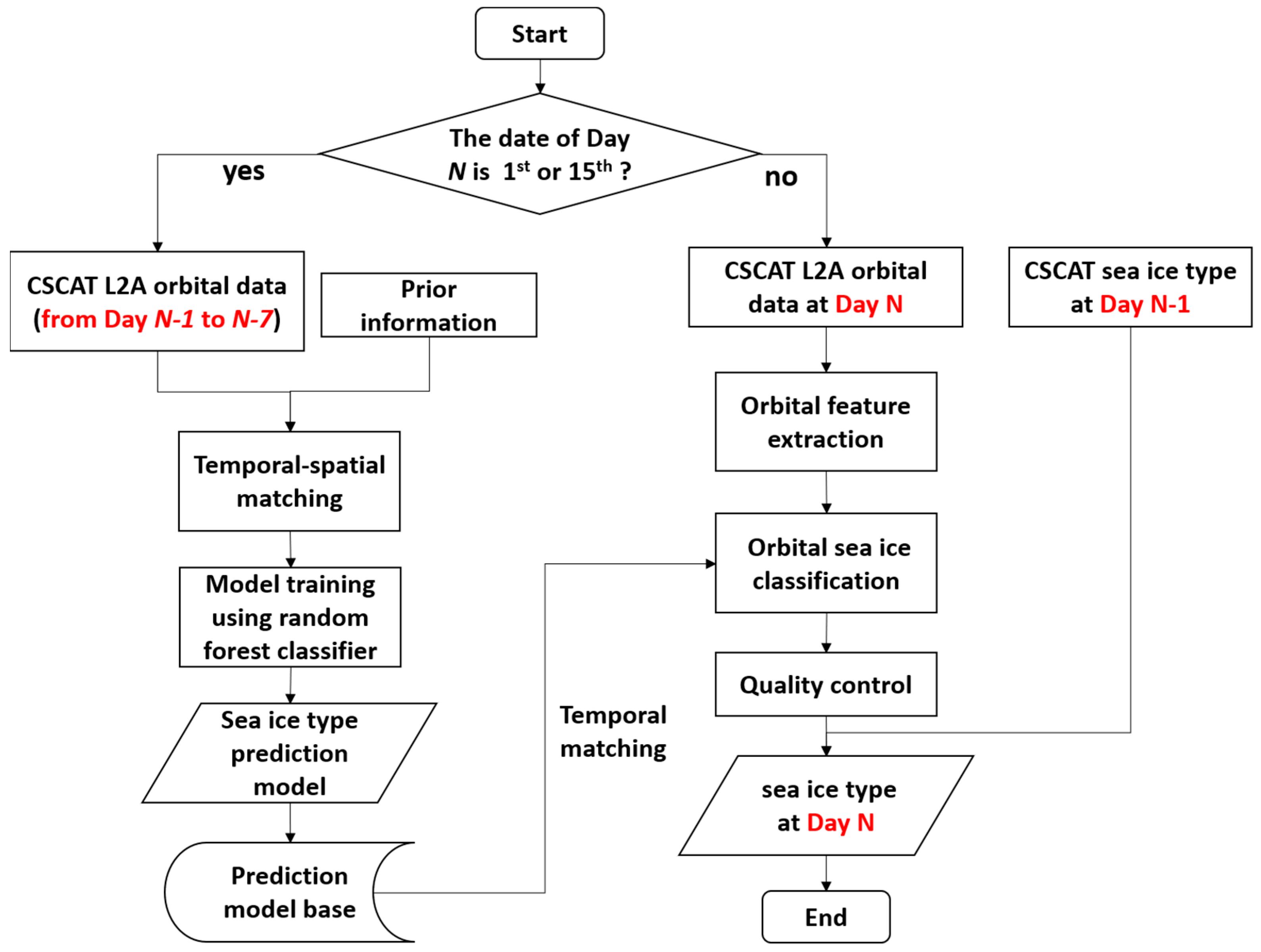
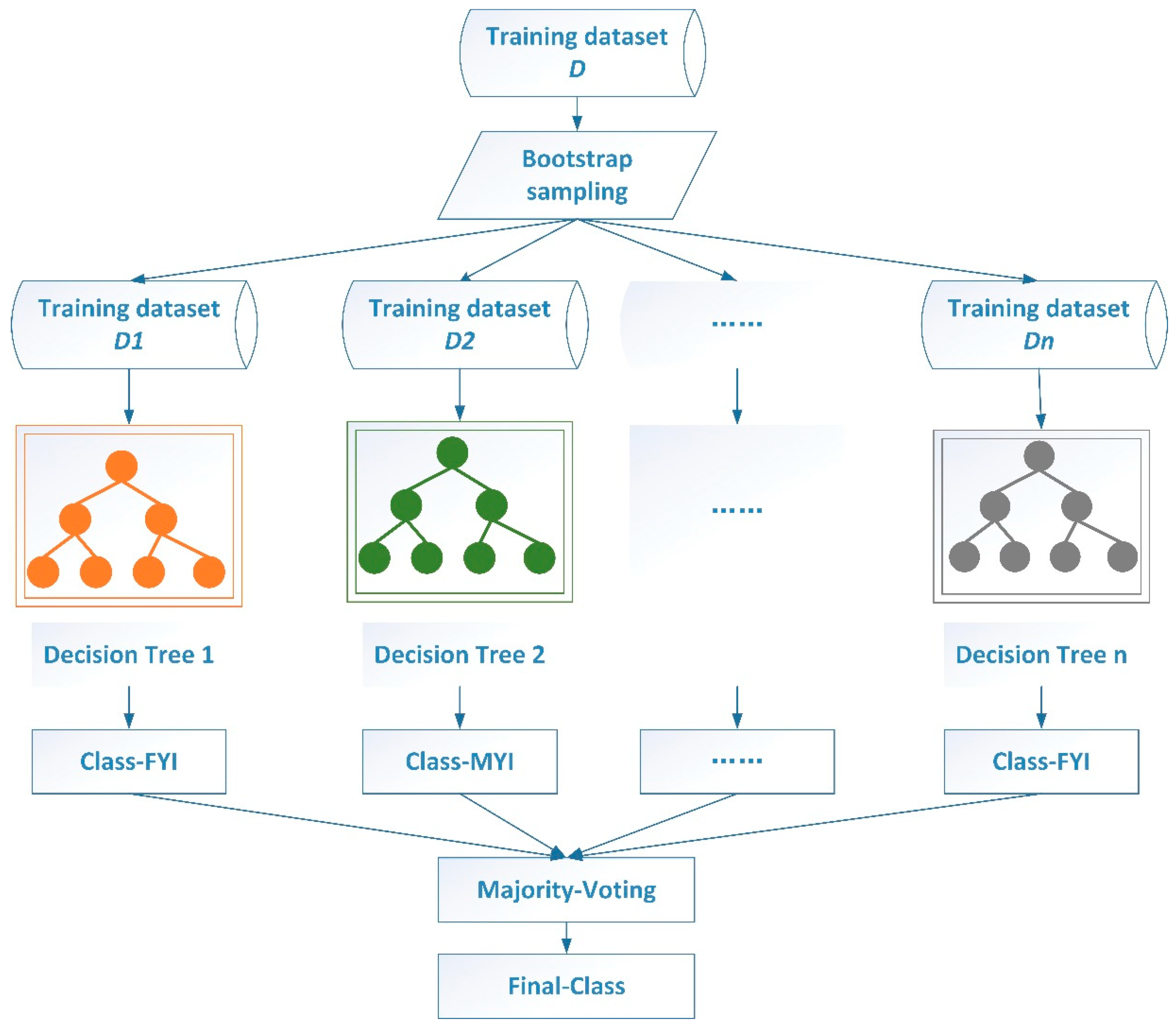
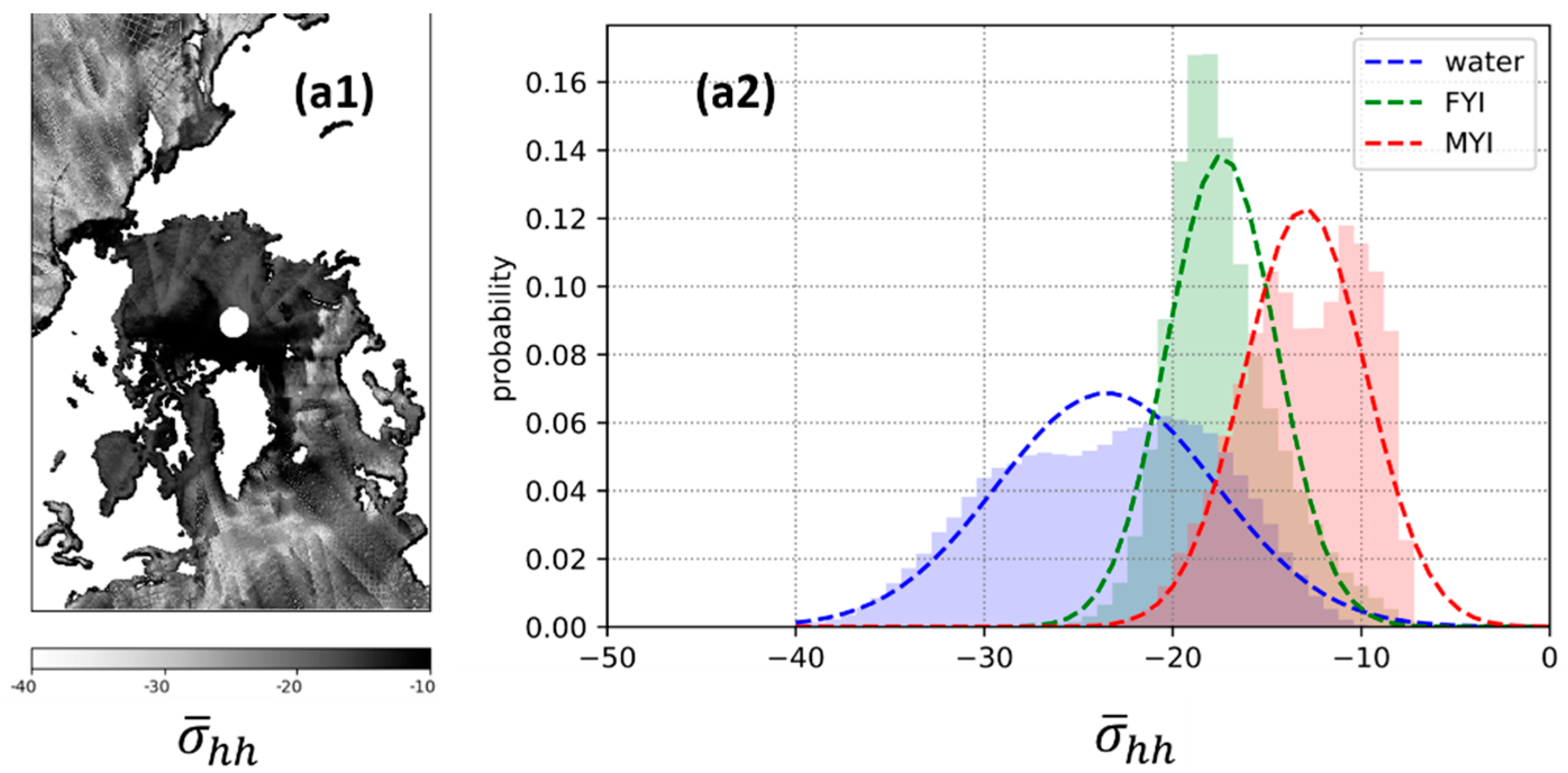


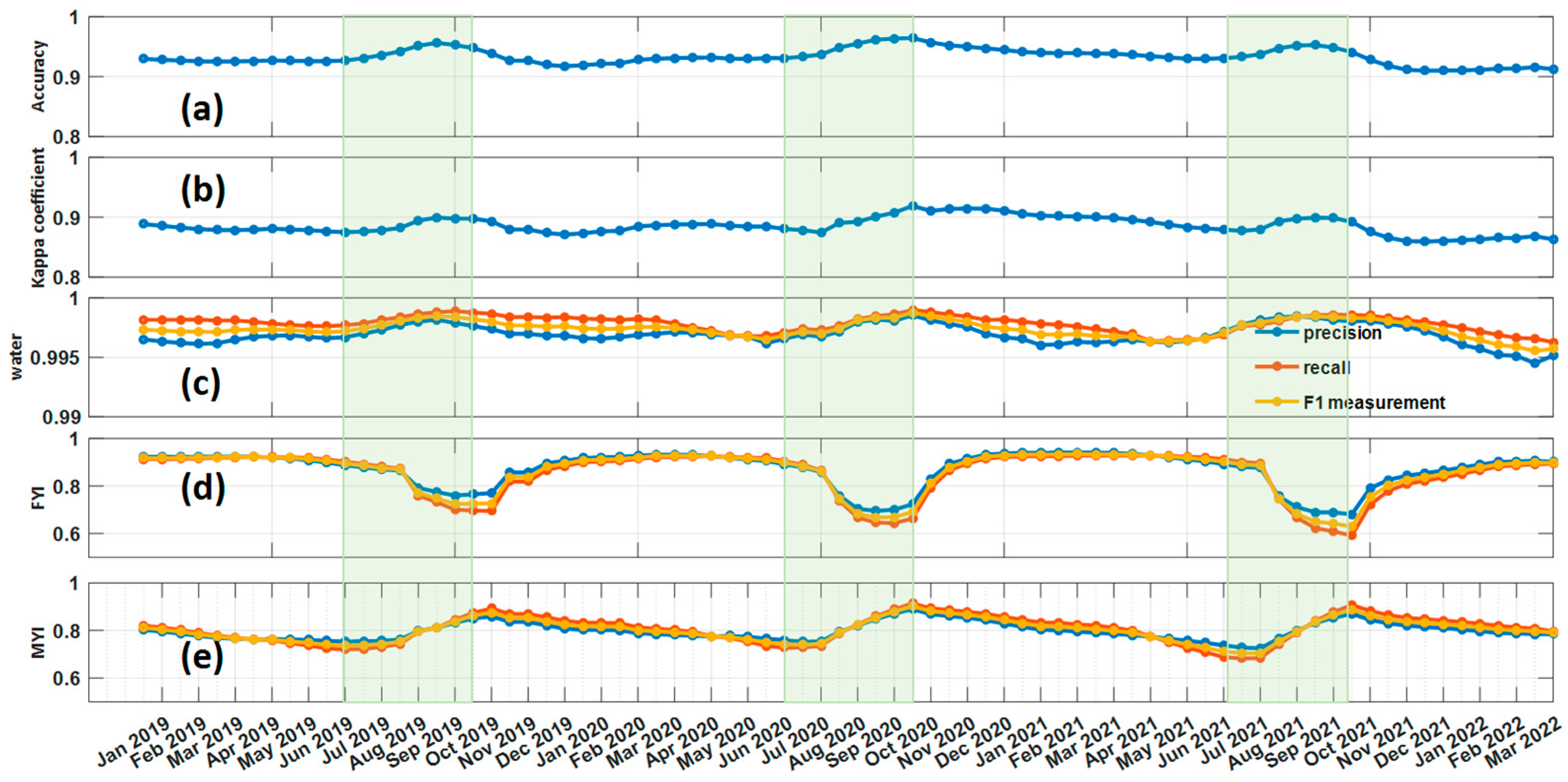
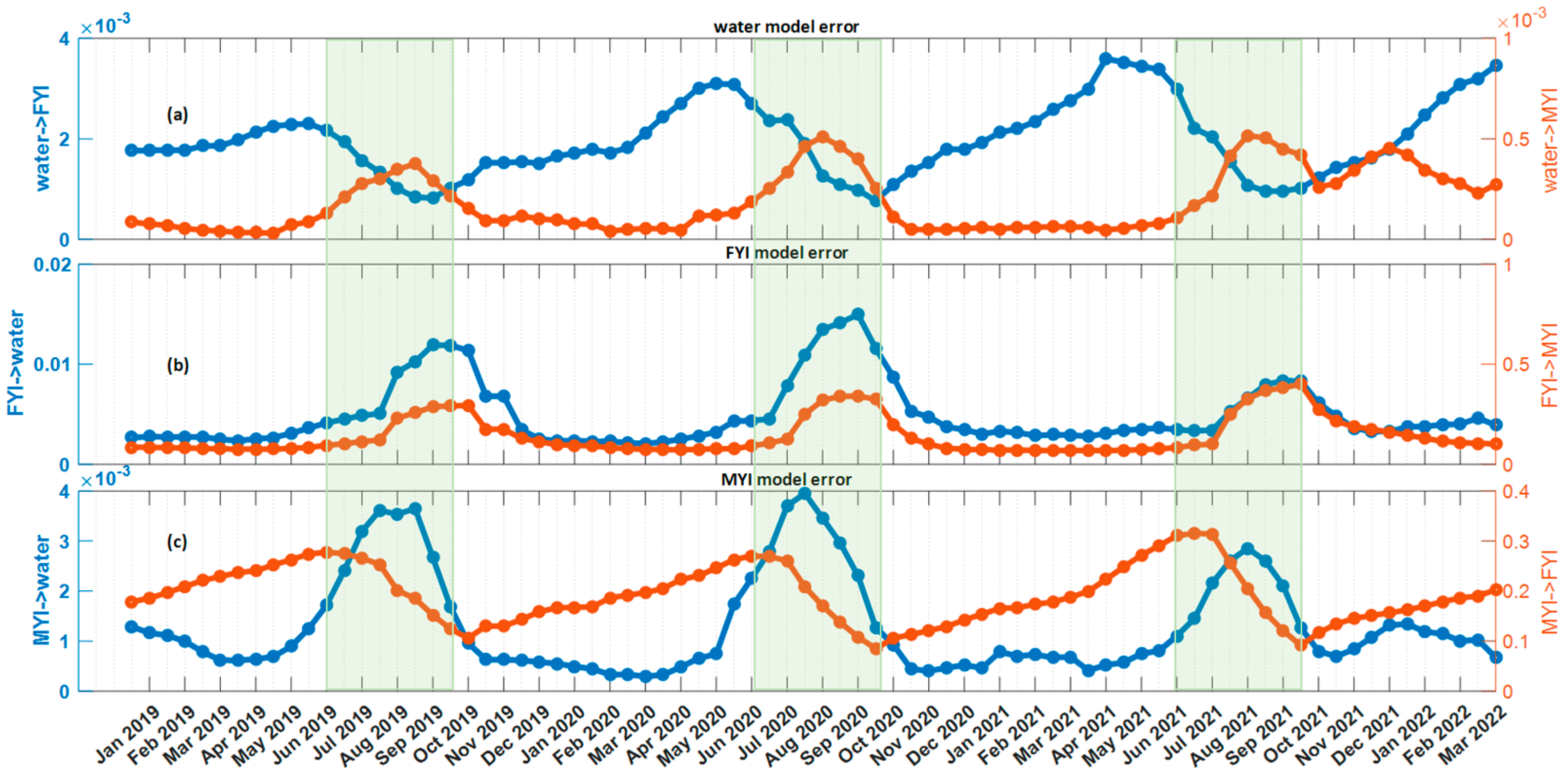
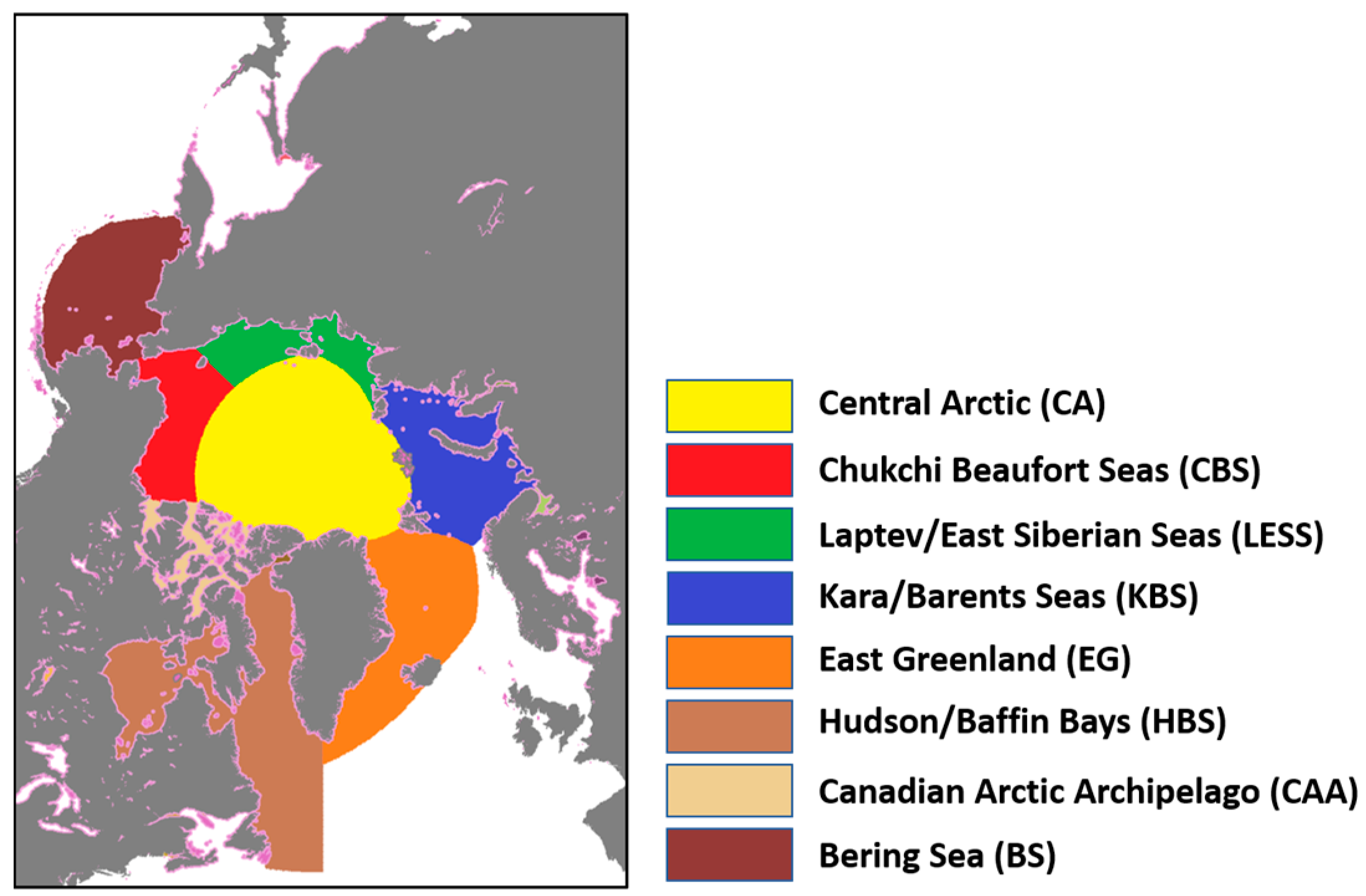
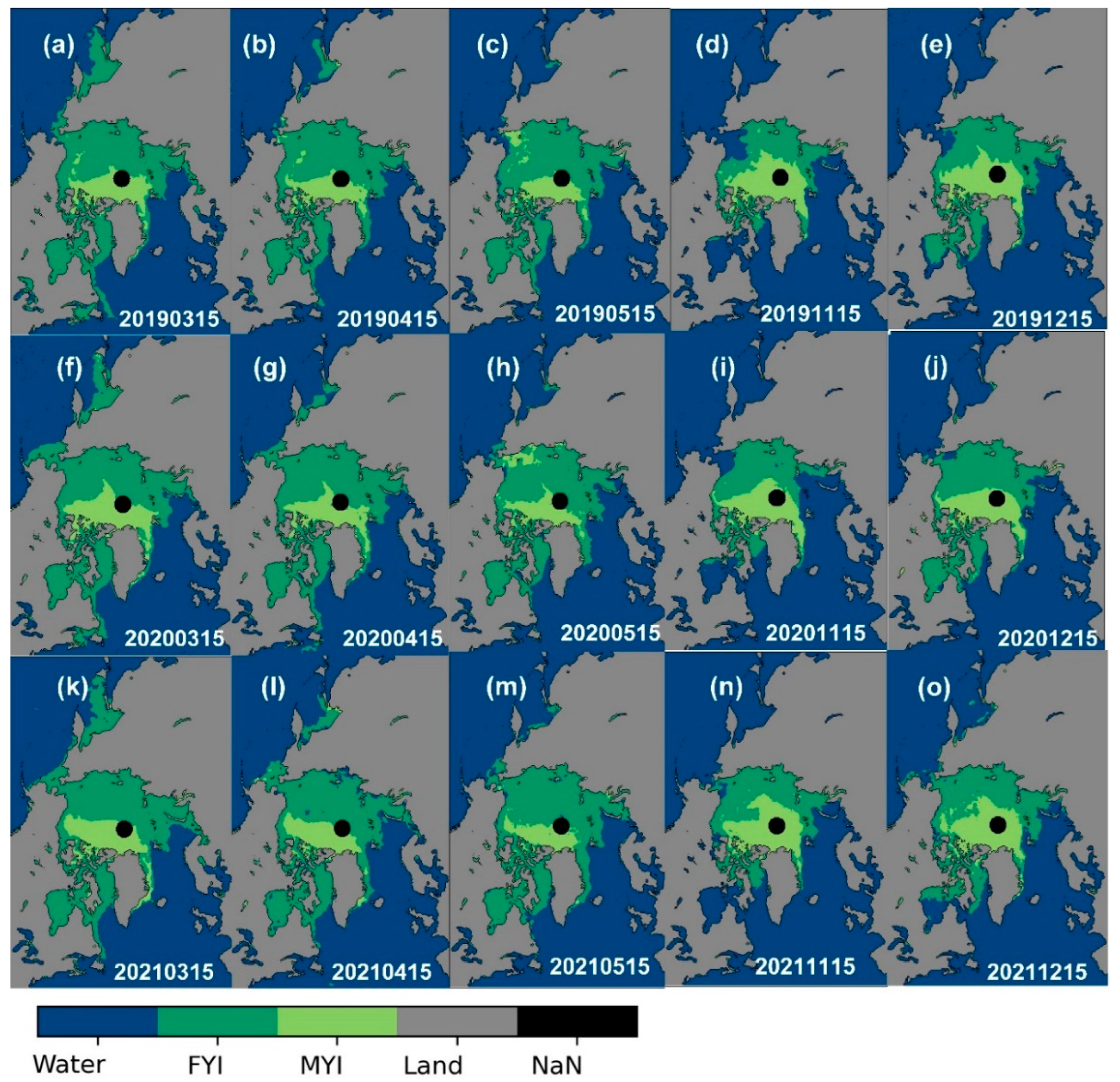
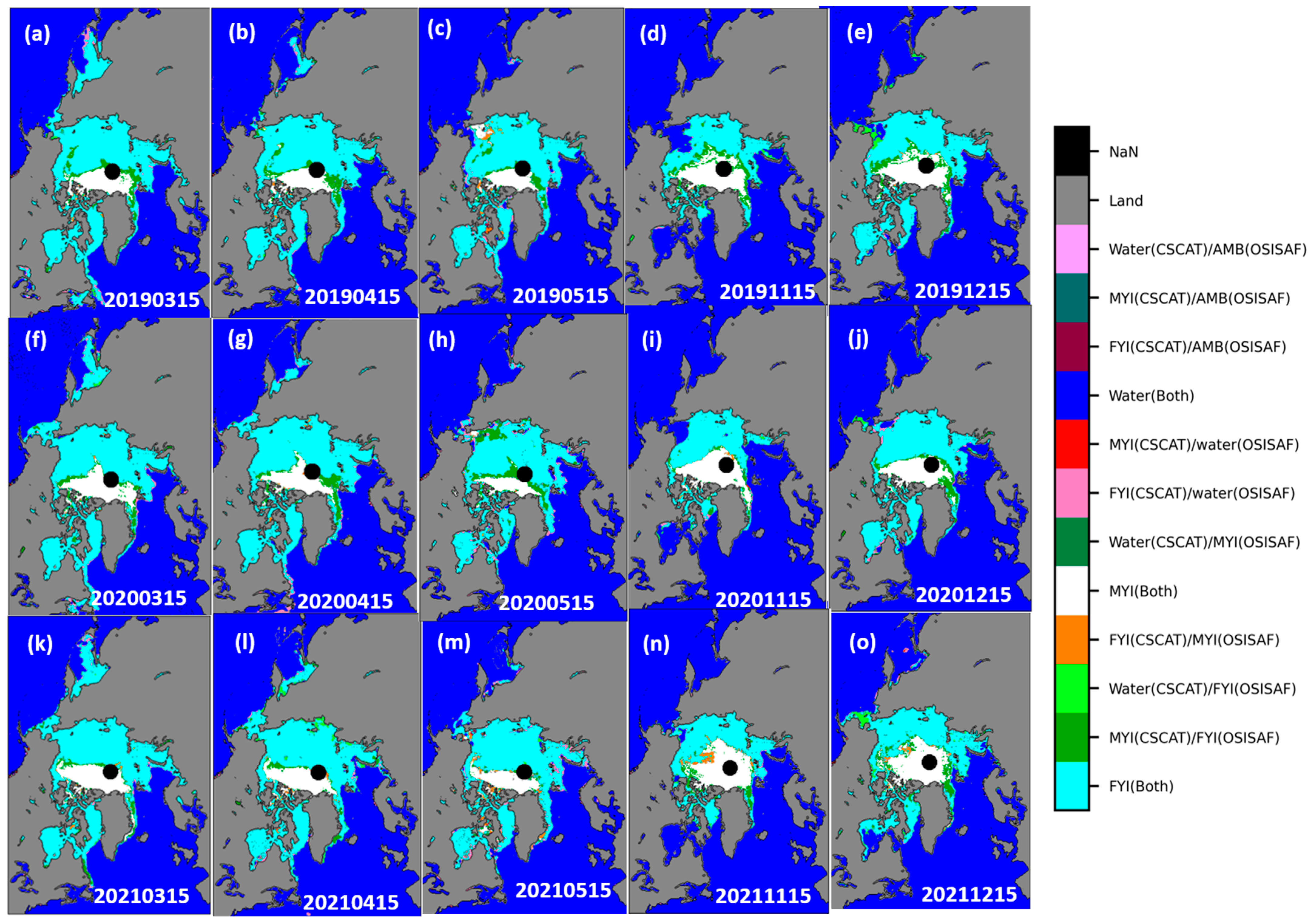
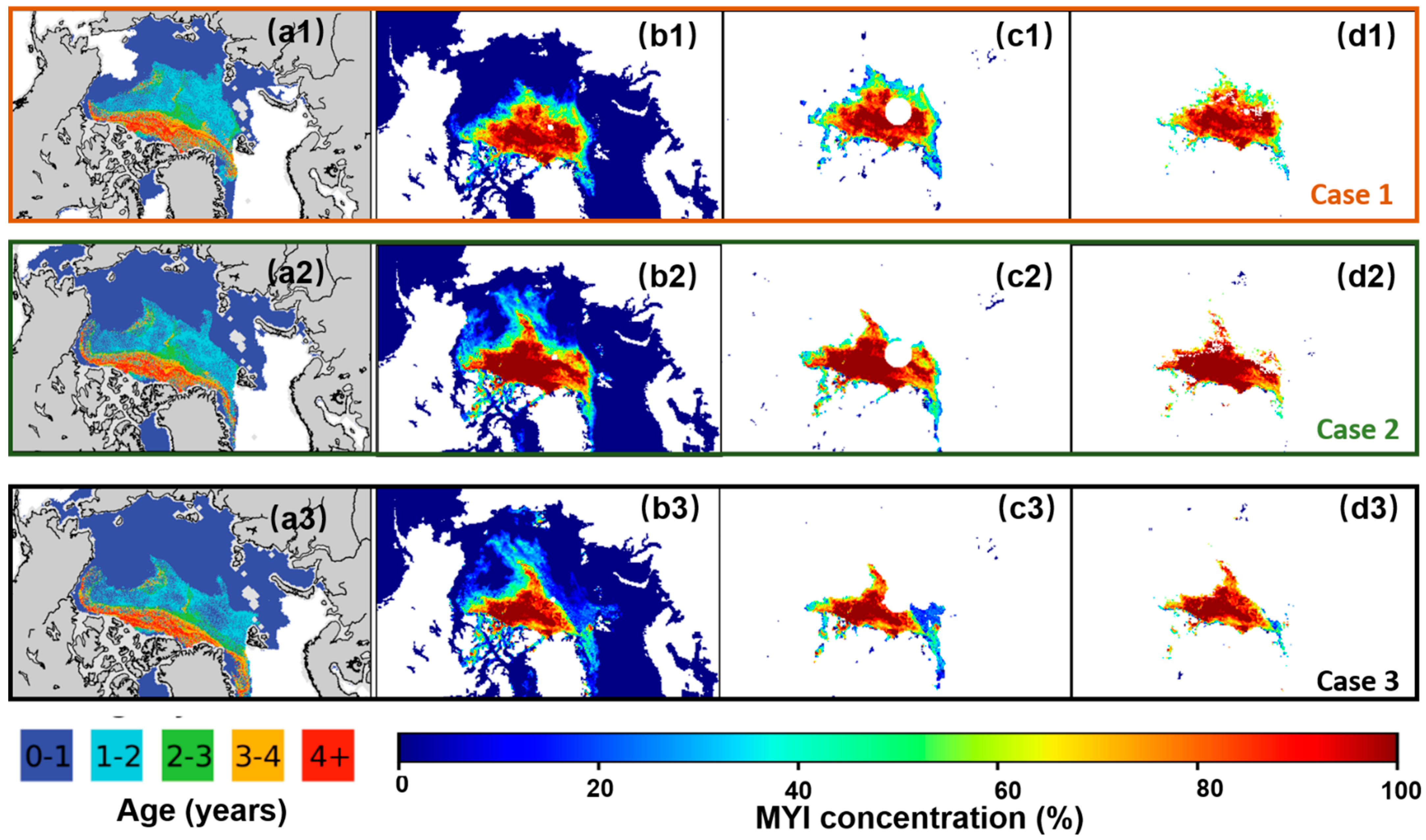
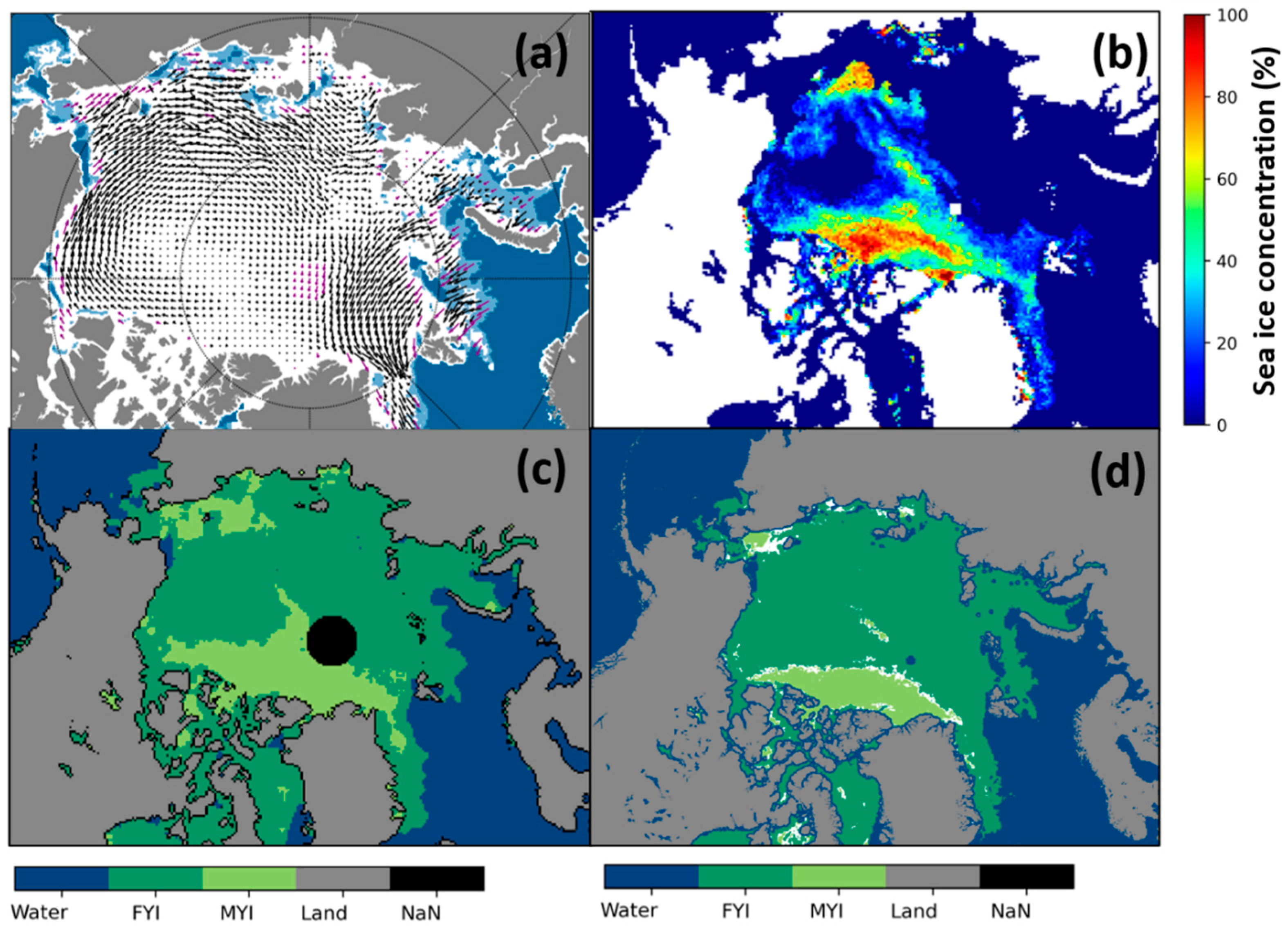
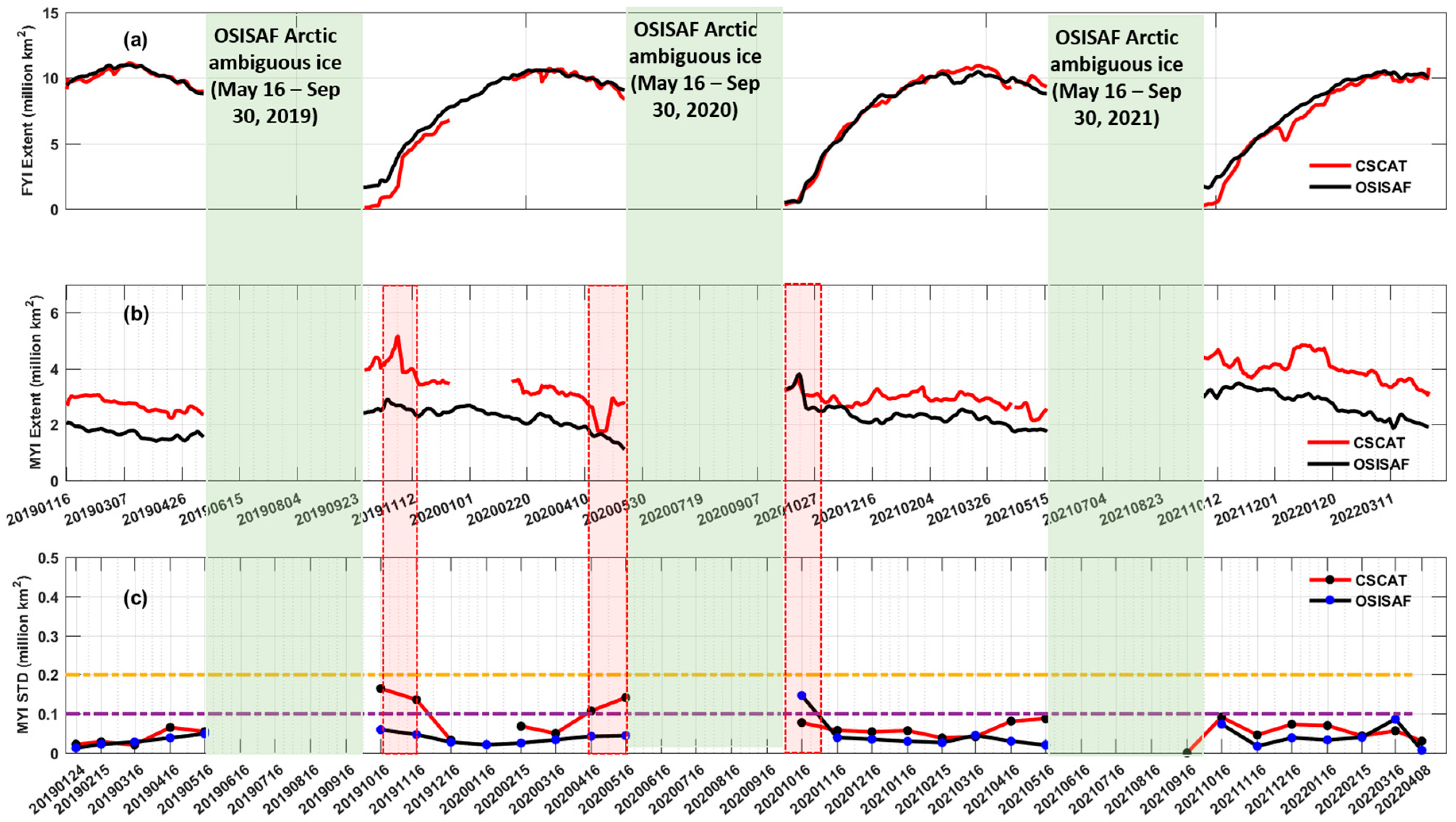
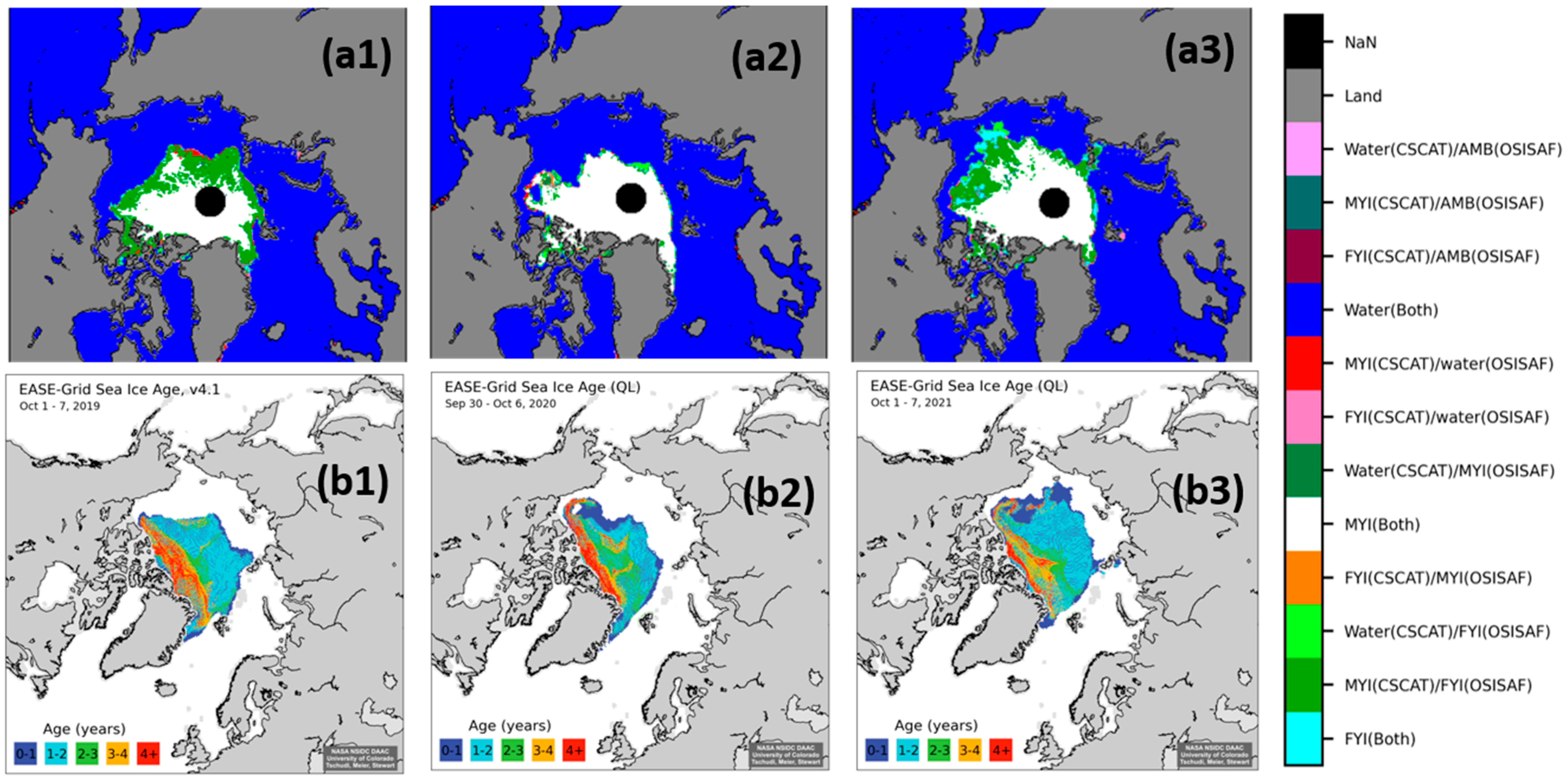
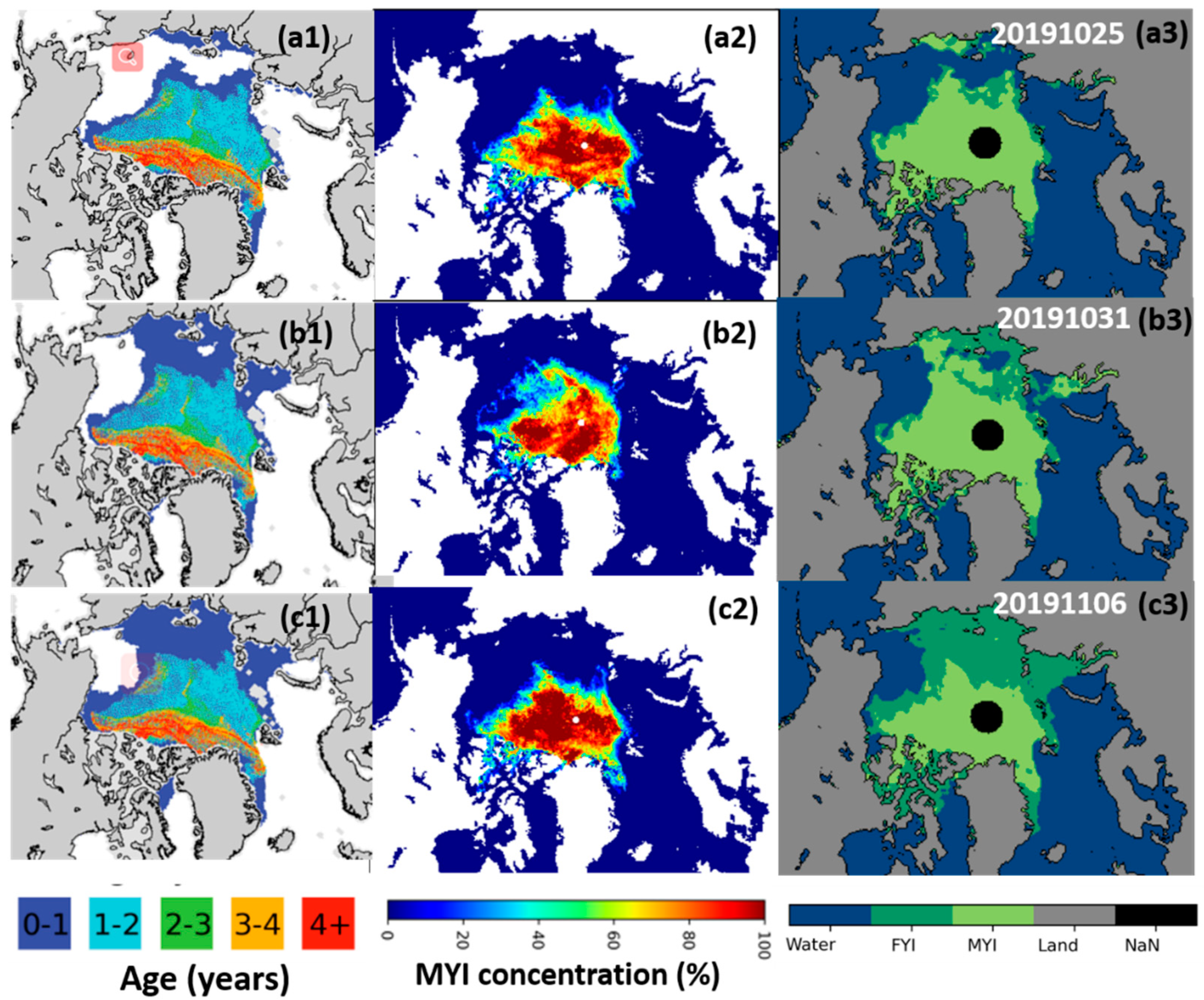

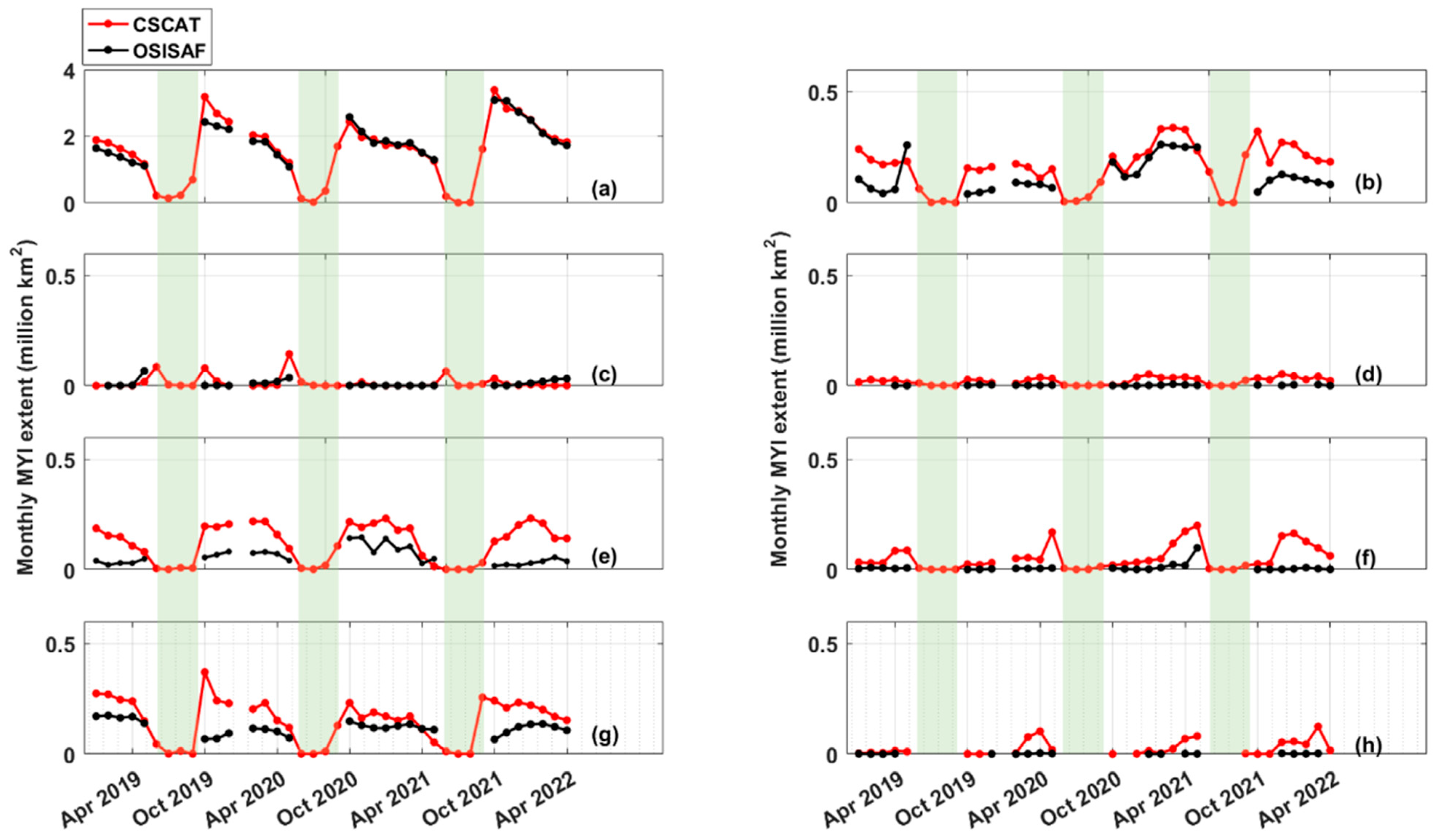
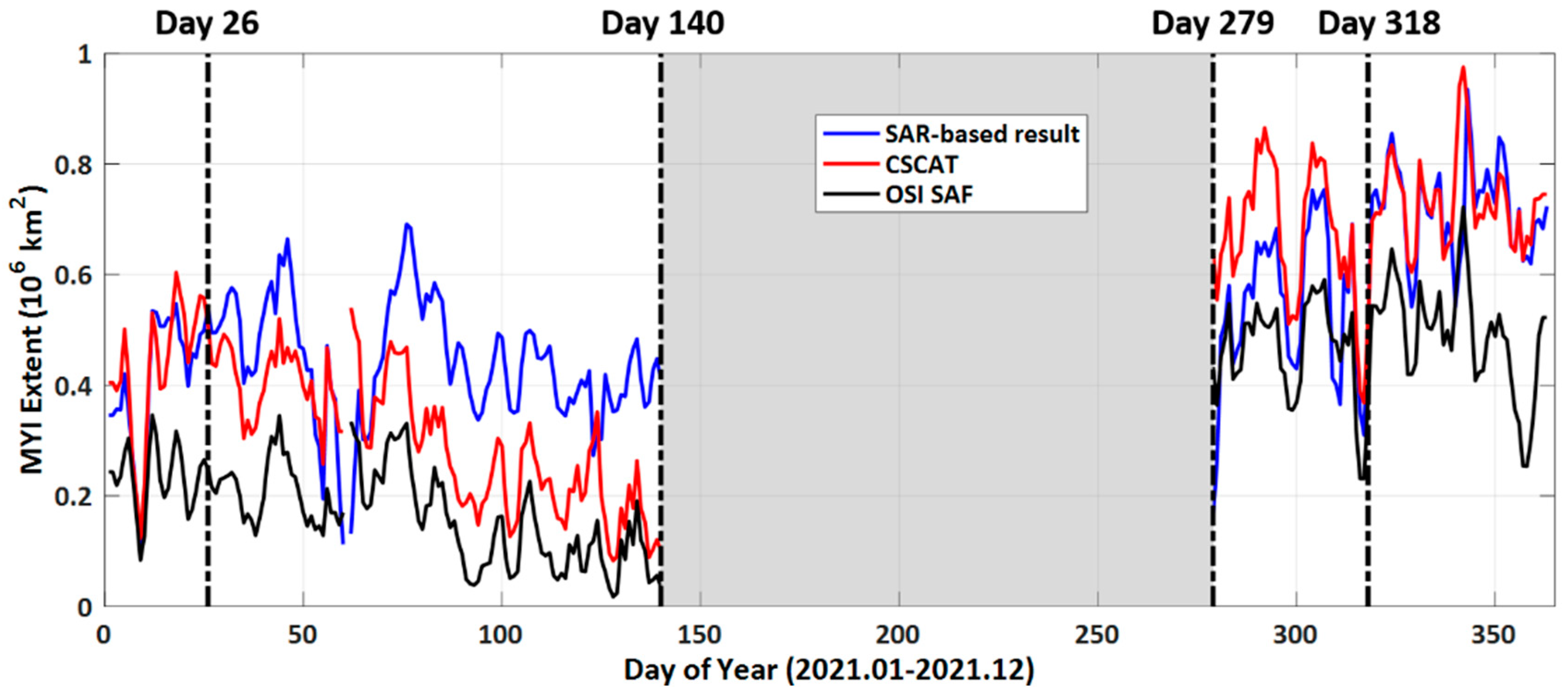
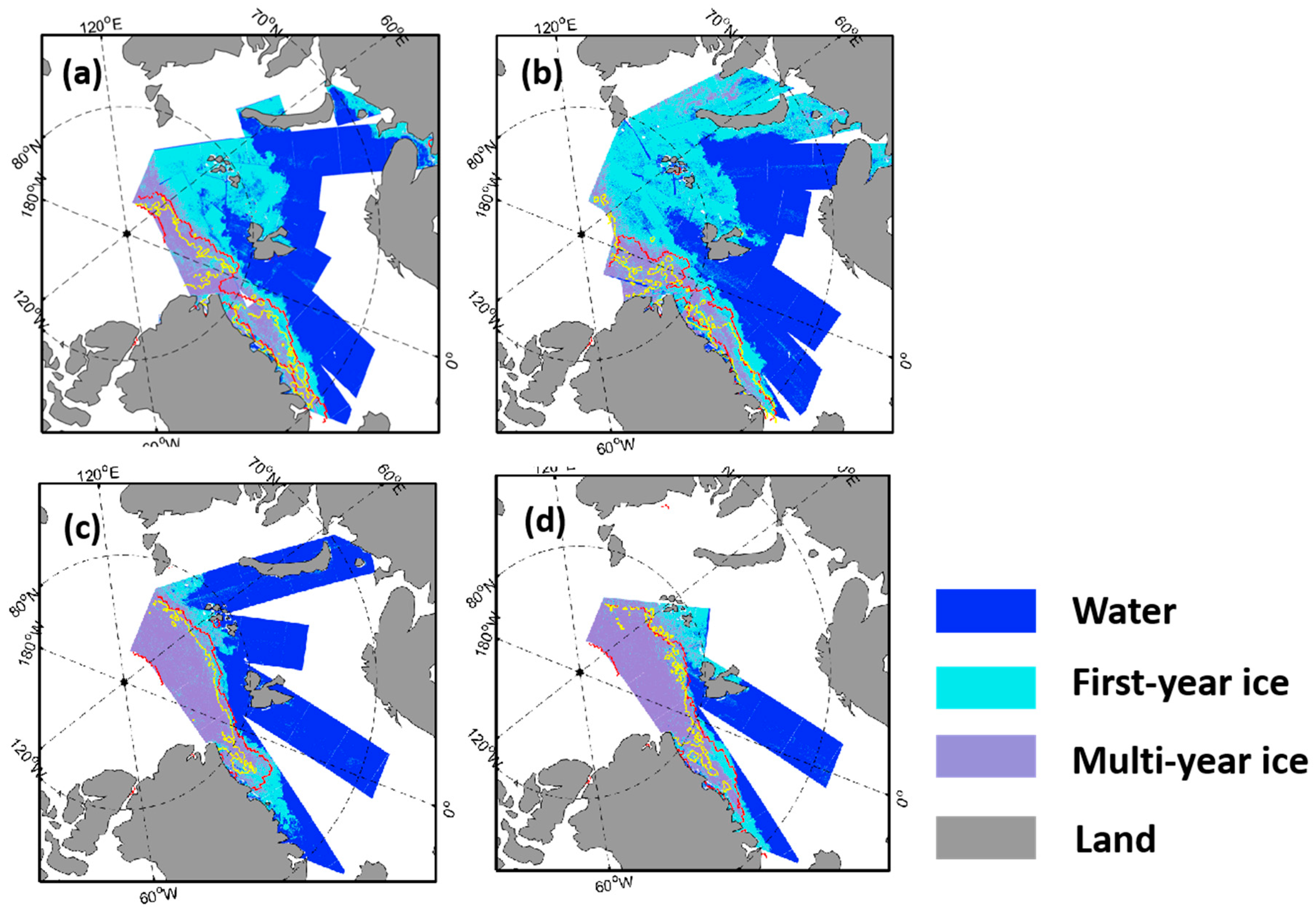
| Mission | ERS-1/2 | ADEOS-1 | QuikSCAT | METOP | OceanSAT-II | HY-2A | CFOSAT |
|---|---|---|---|---|---|---|---|
| Scatterometer | AMI | NSCAT | SeaWinds | ASCAT | OSCAT | SCAT | CSCAT |
| Date | 1991.7–2000.3 1995.4–2011.5 | 1996.8–1997.6 | 1999.6–2009.11 | 2007.6-now | 2009.10–2014.2 | 2011.8–2020.11 | 2018.10-now |
| Institute | ESA | JAXA and NASA | NASA | ESA | ISRO | NSOAS | NSOAS and CNES |
| Frequency (band) | 5.3 GHz (C) | 13.995 GHz (Ku) | 13.4 GHz (Ku) | 5.3 GHz (C) | 13.515 GHz (Ku) | 13.255 GHz (Ku) | 13.256 GHz (Ku) |
| Beam type | Fixed fan-beam | Fixed fan-beam | Rotating pencil-beam | Fixed fan-beam | Rotating pencil-beam | Rotating pencil-beam | Rotating fan-beam |
| polarization | 3 VV | 3 VV × 2 1 HH × 2 | HH (inner) VV (outer) | 3 VV × 2 | HH (inner) VV (outer) | HH (inner) VV (outer) | HH VV |
| Incidence angles | 18–59° | 17–60° | 46°, 54.4° | 25–65° | 49°, 57° | 41°, 48° | 28–51° |
| Sea ice type algorithm | - | K-means | Fixed threshold algorithm; dynamic threshold algorithm; ECICE; K-means | Bayesian classification algorithm; improved ECICE; K-means | Improved dynamic threshold algorithm | Dynamic threshold algorithm; BP Neural network classification algorithm | K-means; random forest classification algorithm; tree augmented naive Bayesian sea ice classification algorithm |
| References | [8,9,10] | [9,11,12,13] | [14,15,16,17,18,19] | [20,21,22] | [20,23] | [24,25] | [26,27,28] |
| Prediction | ||||
|---|---|---|---|---|
| Water | FYI | MYI | ||
| True | Water | a | b | c |
| FYI | d | e | f | |
| MYI | g | h | i | |
| FYI Extent Maximum | FYI Extent Minimum | |||
|---|---|---|---|---|
| Date | Value (Million km2) | Date | Value (Million km2) | |
| CSCAT | 11 March 2019 | 11.6837 | 2 October 2019 | 1.6368 |
| 18 March 2020 | 11.2110 | 3 October 2020 | 0.4953 | |
| 19 March 2021 | 11.515 | 4 October 2021 | 1.6061 | |
| 5 March 2022 | 11.1344 | |||
| OSI SAF | 11 March 2019 | 11.001 | 4 October 2019 | 0.1243 |
| 3 March 2020 | 10.589 | 1 October 2020 | 0.3437 | |
| 19 March 2021 | 10.462 | 30 September 2021 | 0.2067 | |
| 6 March 2022 | 10.513 | |||
Disclaimer/Publisher’s Note: The statements, opinions and data contained in all publications are solely those of the individual author(s) and contributor(s) and not of MDPI and/or the editor(s). MDPI and/or the editor(s) disclaim responsibility for any injury to people or property resulting from any ideas, methods, instructions or products referred to in the content. |
© 2023 by the authors. Licensee MDPI, Basel, Switzerland. This article is an open access article distributed under the terms and conditions of the Creative Commons Attribution (CC BY) license (https://creativecommons.org/licenses/by/4.0/).
Share and Cite
Zhai, X.; Xu, R.; Wang, Z.; Zheng, Z.; Shou, Y.; Tian, S.; Tian, L.; Hu, X.; Chen, L.; Xu, N. Classification of Arctic Sea Ice Type in CFOSAT Scatterometer Measurements Using a Random Forest Classifier. Remote Sens. 2023, 15, 1310. https://doi.org/10.3390/rs15051310
Zhai X, Xu R, Wang Z, Zheng Z, Shou Y, Tian S, Tian L, Hu X, Chen L, Xu N. Classification of Arctic Sea Ice Type in CFOSAT Scatterometer Measurements Using a Random Forest Classifier. Remote Sensing. 2023; 15(5):1310. https://doi.org/10.3390/rs15051310
Chicago/Turabian StyleZhai, Xiaochun, Rui Xu, Zhixiong Wang, Zhaojun Zheng, Yixuan Shou, Shengrong Tian, Lin Tian, Xiuqing Hu, Lin Chen, and Na Xu. 2023. "Classification of Arctic Sea Ice Type in CFOSAT Scatterometer Measurements Using a Random Forest Classifier" Remote Sensing 15, no. 5: 1310. https://doi.org/10.3390/rs15051310
APA StyleZhai, X., Xu, R., Wang, Z., Zheng, Z., Shou, Y., Tian, S., Tian, L., Hu, X., Chen, L., & Xu, N. (2023). Classification of Arctic Sea Ice Type in CFOSAT Scatterometer Measurements Using a Random Forest Classifier. Remote Sensing, 15(5), 1310. https://doi.org/10.3390/rs15051310










